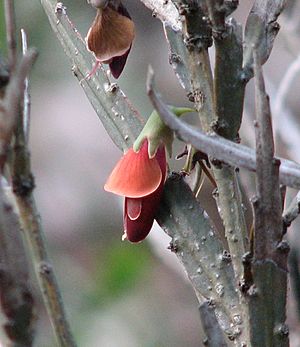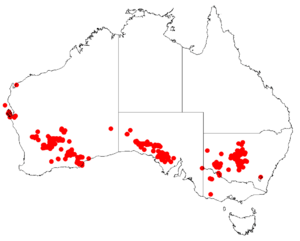Cactus bossiaea facts for kids
Quick facts for kids Cactus bossiaea |
|
|---|---|
 |
|
| Bossiaea walkeri | |
| Scientific classification | |
| Kingdom: | |
| Phylum: | |
| Class: | |
| Order: | |
| Family: | |
| Genus: | |
| Species: |
B. walkeri
|
| Binomial name | |
| Bossiaea walkeri |
|
 |
|
| Occurrence data from AVH | |
The Bossiaea walkeri, also known as cactus bossiaea or cactus pea, is a type of flowering plant. It belongs to the pea family, called Fabaceae. This plant is a leafless shrub. It usually grows to be between 0.5 and 2.5 metres tall. Its pretty flowers appear from July to November in Australia. You can find it in Western Australia, South Australia, Victoria, and New South Wales. The name Bossiaea comes from Joseph Hughes Boissieu Martiniere, a French scientist. The name walkeri honors Alex Walker, who first found this plant in New South Wales.
Contents
What Does Cactus Bossiaea Look Like?
Bossiaea walkeri is a shrub with many tangled branches. It often grows to be about 2 metres wide and 2 metres tall. This gives the shrub a round, bushy shape. What look like waxy green leaves on the branches are actually special stems called cladodes.
Cladodes: Special Stems
The true leaves of Bossiaea walkeri are tiny, like scales, only about 2mm long. The cladodes do the job of leaves. They help the plant make its own food through photosynthesis. They also help it breathe and release water. Cladodes are tougher than leaves. They help the plant save water and don't fall off like regular leaves.
Beautiful Pea-Flowers
This plant has lovely pea-shaped flowers. They are about 2 centimetres wide. You can see them in shades of pink, orange, and red. These flowers bloom between July and November. The flower's top petal (called the standard) is shorter than its side petals (wings) and bottom petals (keel).
Where Does Cactus Bossiaea Grow?
Bossiaea walkeri is found only in Australia. It grows in all states except the Northern Territory.
Australian Habitats
In South Australia, you can find it in the northern Eyre Peninsula. It often grows in mallee woodland areas. It prefers red sandy soils there. It is also common in mallee woodlands in central and south-west New South Wales. You can also find it in inland Western Australia.
Endangered in Victoria
Sadly, Bossiaea walkeri is listed as endangered in Victoria. This means there are not many of these plants left in that state. This plant can grow in different types of soil. It grows in clay, limestone, and yellow sand. It is also the only species of Bossiaea that can live in very dry, arid regions.
How Does Cactus Bossiaea Reproduce?
The flowers of Bossiaea walkeri appear from July to November. Sometimes, they will flower again after a dry period if there is extra rain. This helps them make the most of the water.
Seed Pods and Dispersal
After flowering, the plant produces a fruit. This fruit is a flat, smooth pod. It is about 6 centimetres long and 1 centimetre wide. Inside the pod are brown seeds. The pods start green and turn brown as they get older. The seeds are usually ready about 2 to 3 months after the flowers have finished blooming. On a hot day, these pods can explode! This helps to scatter the seeds several metres away from the parent plant.
Pollination and Honey
Birds are the main animals that help pollinate these flowers. This means they help move pollen from one flower to another. Small animals and insects also help with pollination. Bossiaea walkeri produces a special kind of honey. However, this honey is not usually collected by beekeepers.

